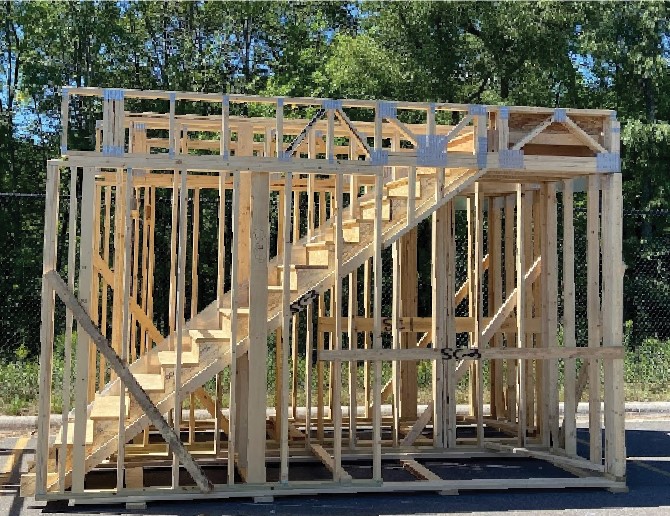Director's Message: Beyond Typical Structural Building Components
Pods Can Provide Additional Value

Component manufacturers (CMs) are notoriously great at adding value. It’s in the DNA of every CM I visit and speak with. They take common materials like wood and metal, apply engineering principles, and produce a product that is greater than the sum of its parts. As we’ve shown with multiple Framing the American Dream projects, a component system’s approach to light-frame construction certainly is the Best Way to Frame.
While roof trusses, wall panels, and floor cassettes provide the overwhelming majority of components used in systems type construction, there are additional ways CMs can continue to deliver additional value to their customers. A few areas where CMs can drive their markets forward are stairs and mechanical-electrical-plumbing (MEP) pods. These two areas typically slow projects down and CMs have an opportunity to boost the overall efficiency of the project for their builder customers.
 Stairs are difficult to build on the jobsite, often requiring several hours, even for the most skilled carpenters. There is an inherent risk of miscuts or miscalculations in the rise and run estimates for proper steps that are easy to ascend and meet code requirements. While skill sets typically exist on jobsites today, to provide this function of the framing process, where will those with that particular set of skills be found in years to come? With the ever-growing skills gap in the framing trade, stairs are a perfect product/process to mechanize.
Stairs are difficult to build on the jobsite, often requiring several hours, even for the most skilled carpenters. There is an inherent risk of miscuts or miscalculations in the rise and run estimates for proper steps that are easy to ascend and meet code requirements. While skill sets typically exist on jobsites today, to provide this function of the framing process, where will those with that particular set of skills be found in years to come? With the ever-growing skills gap in the framing trade, stairs are a perfect product/process to mechanize.
Watching pre-built stairs being lifted into place via a crane or brute strength is a spectacular site. In mere minutes, several hours of jobsite time are saved, increasing access to multiple floors of a project. However, a lot of effort and attention to detail is required for producing the staircase. CMs possess the equipment, knowledge, and technology necessary to build stairs offsite. Operators using computer programs can quickly decipher measurements to provide precise rise and run measurements for perfect steps. Laser projection systems, CNC routers, and/or automated linear saws can make quick work of cutting the stair jacks with little risk and material damage from overcuts. Finally, CMs are ideal for manufacturing and transporting complex products made from wood resulting in a time saving, precise solution for their customers.
 Some CMs are taking it a step further by building what is called a “stair cube,” in which the surrounding walls are built, with the stairs attached to be dropped into place onsite by a crane. This approach saves even more time onsite and neutralizes some of the things that may go wrong with prebuilt staircases. This combines wall panels with prebuilt staircases in more of a volumetric approach. Of course, there are shipping considerations to take into account, and factory to jobsite distance is a factor, but it’s another method for CMs to provide additional value to their customers.
Some CMs are taking it a step further by building what is called a “stair cube,” in which the surrounding walls are built, with the stairs attached to be dropped into place onsite by a crane. This approach saves even more time onsite and neutralizes some of the things that may go wrong with prebuilt staircases. This combines wall panels with prebuilt staircases in more of a volumetric approach. Of course, there are shipping considerations to take into account, and factory to jobsite distance is a factor, but it’s another method for CMs to provide additional value to their customers.
Beyond stairs, another concept recently popping up in certain markets is an MEP closet, also called an MEP pod. Think about a typical mechanical room, framed offsite with many of the systems connected to the walls to minimize installation time for the MEP trades onsite. Water heaters, exterior facing mini-split systems, electrical panels, plumbing manifolds, and other items can be installed in a factory setting with better quality control and environmental conditions. While CMs don’t typically possess all of the skillsets required to perform this work in their factory, they can certainly partner with local trades to come in and perform their work on several pods at a time, driving efficiency for their customers.
While SBCA continues to work with our members on driving the usage of component systems for light-frame wood construction, it is exciting to know there are plenty of additional solutions CMs can add to their product line to provide advanced, innovative solutions to their customers. All of this starts with conversations and creating feedback loops between CMs and others involved with the jobsite, including general contractors, trades, and other suppliers. Like-minded construction professionals with some creativity can develop the next generation of solutions CMs can provide to reduce cycle times and construction expenses while driving efficiency and the adoption of components.
Jess Lohse, Executive Director
